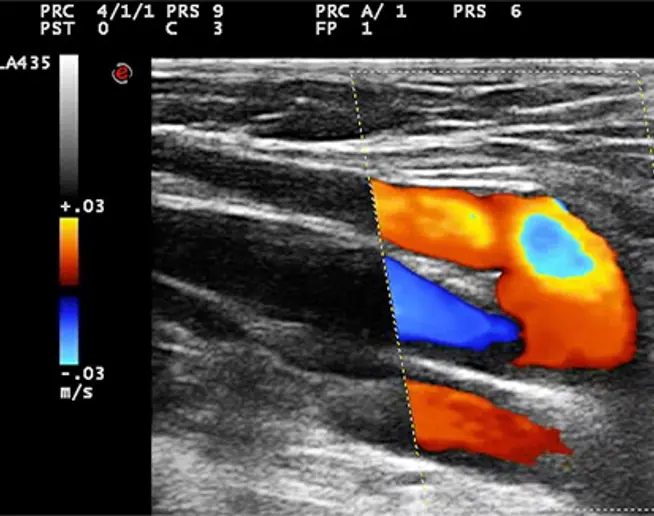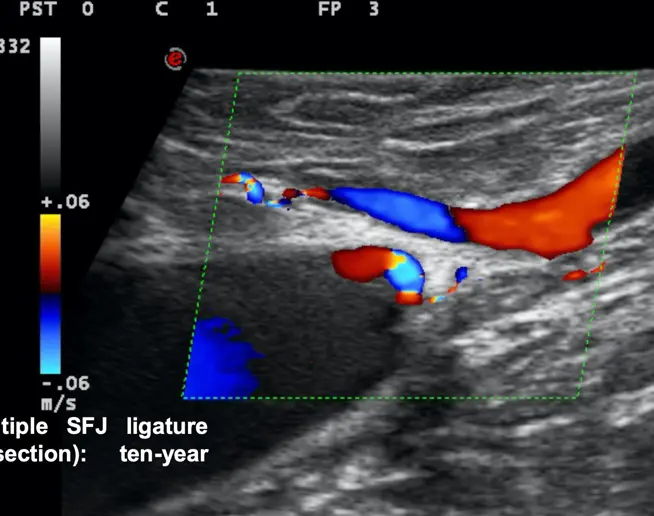Cure Conservatrice et Hemodynamique de l’Insuffisance Veineuse en Ambulatoire
C.H.I.V.A
C.H.I.V.A. precursors
A century later Claude Franceschi took over the hemodynamic approach and developed complementary concepts thanks to the Doppler Ultrasound vascular investigation he pioneered and published in the very first book in 1977 as well as the first vascular Ultrasound imaging book in 1986. He studied fluid mechanics to understand his observations, then he proposed a hemodynamic model of venous pathophysiology.
The acronym C.H.I.V.A. stands for “cure Conservatrice et Hemodynamique de l’Insuffisance Veineuse en Ambulatoire": conservative and hemodynamic treatment of venous insufficiency in out-patients. This treatment was proposed by Claude Franceschi in October 1988 at a scientific meeting in Précys-sous- Thil. It represents a therapeutic approach to treating Chronic Venous Insufficiency (CVI) of the lower limbs in outpatients, with a focus on preserving the venous system and the Great Saphenous Vein (GSV) while ensuring the restoration of tissue drainage. (scegliere foto)
CHIVA is based on a new Hemodynamic Model of Venous Pathophysiology where venous insufficiency is defined as the inability of the venous system to maintain a normal venous trans-mural pressure TMP, to fulfill its functions of tissue drainage, right heart pre-load, and thermoregulation. So, the excess of TMP is regarded as the cause of the symptoms and signs of venous insufficiency. Consequently, restoring a normal TMP is considered mandatory and sufficient to cure this disease
- Tissue drainage: proper venous return helps remove metabolic waste products from tissues.
- Right heart preload: venous return is critical to maintaining the volume and pressure required to fill the right side of the heart, ensuring efficient circulation.
- Thermoregulation: the venous system plays a role in heat distribution and regulation.
Key Components of C.H.I.V.A. Treatment
Chronic Venous Insufficiency (CVI): This is a condition where the veins in the legs fail to efficiently return blood to the heart, often leading to symptoms like swelling, pain, varicose veins, and skin changes. It occurs when the venous valves in the legs become damaged or weakened, leading to blood pooling in the lower extremities.
Conservative and hemodynamic treatment: C.H.I.V.A. preserves the venous system as much as possible, avoiding the creation of closed, non-draining systems to have long-term stability. The goal is to prevent further damage to the veins and ensure proper circulation.
Preserving the Venous System and GSV: Traditional treatments often involve stripping or ablation of the GSV, but the C.H.I.V.A. method emphasizes conservative treatment, where the GSV is left intact as much as possible. This is because the GSV plays a crucial role in venous drainage and preserving its function can help restore normal circulation, and also because GSV can be useful for bypasses.
Restoring Tissue Drainage: by managing the venous insufficiency through this approach, the aim is to improve blood flow and tissue drainage, alleviating the symptoms of CVI. This can help prevent complications like ulcerations or skin changes due to chronic poor circulation.

Treatment Approach
Minimally invasive procedures under local anesthesia and previous B-mode skin marking.
Personalized care
The treatment is highly tailored to the individual patient's shunt type.
Long-term management: One of the advantages of this approach is that it can be part of a more sustainable management plan, where patients may have a longer-lasting resolution of their symptoms.
Advantages of C.H.I.V.A:
- Less invasive: Compared to traditional methods like vein stripping, or endovenous thermal ablations, C.H.I.V.A. is more targeted and minimally invasive, resulting in quicker recovery times and fewer risks.
- Preservation of venous anatomy: By keeping the GSV intact, the procedure maintains the overall venous architecture of the leg, which could lead to better long-term outcomes in terms of circulation. Destroying therapies in IVC reduce tissue drainage capacity and residual veins will increase their workload

